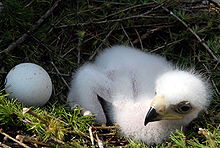chick
A chick (in Austria and chicks , Wuserl or Singerl , Swabian Bibberle , Swiss German Bibeli, bairisch Biberl , ostmitteldeutsch also chickens , Kippchen , scales or Schüpplein ) is in the ornithology a young animal of Birds (freshly hatched to juvenile ). Chicks are usually characterized - similar to other young animals - by a clumsy body with an oversized head, large beak and large eyes ( child pattern ).
The word is particularly known for poultry such as duck , domestic chicken , domestic goose and swan , for whose young animals a number of other names are used.
feather dress
Most chicks, depending on the species or subspecies , have very differently colored downy feathers that are already formed in the egg. With the help of an egg tooth, they can find their way out into the open air and will not eat anything in the first few days if they are full (because of the egg yolk from which they hatched). The down feathers are surrounded by a thin layer of keratin when they hatch , which tears and falls off when the chick dries and after hatching. This is what gives the chick its typical, fluffy appearance. However, this will not last long. The change of the downy feathers ( moulting ) for a first plumage in the first few weeks gives the growing chick an unfinished, plucked appearance. Since fully formed feathers no longer grow, many birds continue to change their feathers in the growth phase.
The color of the original downy feathers often differs from that of the adult animal and usually has a camouflage function. Just as the fabric coloring usually serves as camouflage . A conspicuously light yellow downy feather dress is the exception for chicks, but due to the use of light yellow chicken chicks as a "symbol of life" at Easter this is the common association with the term chick in broad sections of the population .
behavior

The bird species can be categorized according to nesting and fleeing nest .
Chicks that are nestled spend the first days of their lives exclusively in the nest, where they are warmed and fed by their parents. To keep the nest clean, the parent animals remove the chicks' excrement. In the absence of parents, chicks behave calmly. As soon as they notice their parents, they are loudly begged for food. Examples are eagle or blackbird. When they fledge, they leave the nest.
Most species flee nests and follow their parent animals from an early age, such as chickens, ducks and geese. The chicks are often not fed directly by the parent animals, but are shown suitable food. Communication then takes place using special sounds. In the event of danger, they usually seek protection from the parent animal. Often they also hide and only leave cover again on a special call from a parent animal. The adult birds defend their offspring.
Industrial chick production

The global chick market is now dominated by only three groups. 95 percent of the chicks are produced by them. Hybrid chickens are bred for industrial agriculture , these either put on a lot of meat or are optimized for laying eggs. While male and female birds are suitable for meat production, egg producers have no use for the male chicks of the laying hen breeds (because male chickens naturally do not lay eggs). They are therefore often not reared, but killed immediately after hatching. In Germany alone these are around 50 million male chicks per year. The animals are either gassed with CO 2 or shredded .
Sex determination
The sex of a chick can be identified by turning the cloaca inside out.
Web links
- A chick hatches
- Different stages of development of the Vorwerkhuhn
- Video: Brabant chicks hatching, chick hatching, Naissance du Poussin
- Impressions from industrial chick breeding in Germany (NDR documentation)




